Aspley Guise Windmill
Behind the lower part of Woburn Sands, in Aspley Guise parish, once stood a wind mill. Nearby was a water mill on the small brook that runs through the area. There are references to another windmill, on Wednesdon Hill, to the east of Aspley, but by 1761 it had ceased to exist. Any remaining traces of that mill were removed when a sand pit was dug on the site. The rest of this research centres on the first mill which was behind the old Weathercock Farm, off Mill Lane. Most references to the businesses here just use the term ‘Mill’ or ‘Mills’ for either or both the water and wind mill, which seem to have been managed by one miller, so I am going to treat it as one entity.
This mill stood just off the lane named after it, which leaves Burrows Close and becomes Mill Way. This unmade-up trackway eventually joins Salford Road. It makes for a leveller roadway to get from Aspley Guise centre to Wavendon when compared to using West Hill and is much shorter than using Salford and Cranfield Road.
Milling was obviously an important part of the rural agricultural process and a mill is noted as belonging to the Manor of Aspley in the great Domesday Book of 1086. This continued quietly serving the local farming community for centuries. Aspley had two mills noted in a licence granted to Sir Richard Lee to alienate the manor in 1560. Lee was then Lord of the Manor here and held office under King Henry VIII as a surveyor. He died in 1575.
Certainly the later version of this wind mill (of which photos exist) was a post-mill. The traditional image of a windmill is stone or brick-built, with a wooden-domed top, to which the sails are attached. This top part can be spun around to face the wind. A post-mill was an entirely wooden affair. The whole building rested on a central post and could be turned around to face the wind by means of a long tailpiece at the base. As these mills were built of wood, it is certain that from time-to-time they were renewed and replaced on the same sites.
In 1652 Edmund Hardinge of Aspley Guise conveyed by will or lease [BARS: HW14]. to trustees for sale, two mills and a windmill with all “Holmes, millpondes, milldames meadows” etc., all of which lay together. There is a Conveyance of 1657 [BARS: NC865] of two watermills and one windmill on a one-acre site.
The next reference to the mills at Bedfordshire Archives is from about 1670 in the one surviving page of a lease from Mercy Cartwright to Charles Fenn [BARS: HW24], presumably of the mills, as there is a stipulation that:
“The said Charles Fenn… shall not, nor will use any Art to take or Catch ffish, in, or out of the mill pond, Except with an Angle Rod, Nor shall suffer any person or persons whatsoever, to Kill, take or Catch ffish any manner of ways out, or in, the mill pond aforesaid belonging to the watermill; and shall ffind and provide at his Cost and Charge, Materials and workmanship for Cogges and Rounds and sayle barrs (so called) notwithstanding what’s been written…”
An Inventory of Benefices was taken in 1707 for the Archdeaconry of Bedford, noting “the Sandfield next Windmill and Church Hill” as also in “Windmill Furlong.”
An estate map of c.1745 [BARS: X1/30] shows a little drawing of a windmill on the site, as well as the Wednesden Hill one. Their next document mentioning the mills is from May 1758 when Richard How senior conveyed:
– a Windmill in the occupation of John Wilbee and parcel of ground wherein the same stands, 5 acres, known as the Windmill Piece, in Aspley Guise in the occupation of said Richard How senior
– two watermills in said parish also in the occupation of John Wilbee.
– messuage also in the occupation of said John Wilbee called the Millers House with appurtenances in Aspley Guise adjoining the said water mills west
…to Richard How junr. [BARS: V354-356].
The Aspley Guise Enclosure Map [BARS: MA94] of 1761 shows a windmill mapped on the North side of the water-mill, as does Thomas Jefferys’ map of Bedfordshire from 1765.
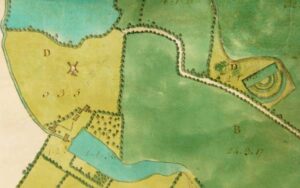
By 1796 Sarah How, widow of Briggins How, had inherited mills and in that year, she released them to a trustee in order to bar dower [BARS: V359-360] and they were promptly sold. The sale document included:
– Miller’s House in Aspley Guise
– messuage adjoining above sometime since erected
– water mill for grinding corn near said messuages
– wind mill for grinding corn near said messuages
– Mill Pond or Mill Dam 1 acre 2 roods 5 perches adjoining said water mills
– orchard in Aspley Guise adjoining Mill Pond 3 acres 20 perches
– pightle or pasture in Aspley Guise adjoining Mill Pond 1 rood 15 perches
– pightle or pasture in Aspley Guise called Mill Way leading from said messuages and mills to the road leading from Aspley Guise to the Turnpike Road
– parcel of arable in Aspley Guise whereon the said windmill is standing called Mill Close 6 acres 33 perches in the occupation of John Clayton
We are now into the age of newspapers and early local coverage for our area appeared in the Northampton Mercury, with the following advert appearing 4th June 1796:
“Bedfordshire Freehold Estates, Tythe-free, a small Modus excepted, settled by Act of Parliament. To be SOLD by AUCTION, by Mr. SHAW, At the Goat Inn, in Woburn, Friday July the 1st, 1796, at Three o’Clock, A valuable Freehold ESTATE, In Two Lots.
Lot 1 CONSISTS of a good-accustomed Water and Wind-Mill, a convenient Dwelling-House, Barn, Stable, Hogsties, and a small Cottage nearly adjoining, with Orchard, Garden, Close called Mill Close, and other Pieces, and Parcels of rich inclosed Arable Sweard Land; containing together seven Acres and a Half, more or less. The Whole in the Tenure of Mr. J. Clayton, who has Notice to leave the same at Michaelmas next.
Lot 2 consists of a good accustomed Inn, called the Weather-Cock, on Woburn Sands, with Stabling for twenty Horses, Barns, Cow-House, Hogsties, &c, a Garden, Orchard, and four Closes of rich Sweard and Arable Land adjoining containing together twenty-five Acres more or it, in the Tenure of Mr Michael Hatton, at Will.
The Whole in the Parish ASPLEY, adjoining the Turnpike-Road from London to Northampton.
May be viewed by Leave of the Tenants, and Particulars had ten Days before the Sale, at the Swans, Newport and Leighton; White-Hart, Ampthill; at the place of Sale; and Mr. Shaw, Woburn.”
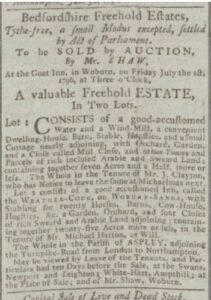
I expect Clayton was hoping the new owner would keep him on as a tenant, but it was not to be. This appeared in the Northampton Mercury on 23rd September 1797:
“To be SOLD by AUCTION, By Mr. SHAW, On Thursday, September the 28th, 1797, at Ten o’Clock,
THE FARMING STOCK, Part of the HOUSEHOLD-FURNITURE, &c. of Mr. CLAYTON, At ASPLEY MILL, near Woburn, who is retiring from Business: Consisting of a good Waggon, Cart, Tax Cart and Harness; four good Draught Horses; a Cow, two fat Hogs, a Cock of fine Hay, a Rick of Oats, Fire-Wood, Dung, Horse Harness, Ploughs, Harrows, Roll, Ladders, Hurdles, a Copper and Irons, Brewing Utensils, and Iron-bound Calks; Tables, Chairs, Beds and Bedding, &c. &c.”
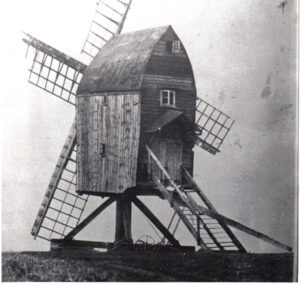
“On Saturday last, an inquisition was taken at Aspley Guise, the county of Bedford, before R. A. Reddall, Gent, coroner for the honour of Ampthill, upon view of the body of William Reey, who the day preceding, together with one of the sons of Mr. Smith, farmer, of that parish, went into Aspley windmill, and just as they had descended from the same, a sudden gust of wind broke off one of the sails and blew it over the mill. Hearing a violent crack, they both ran from the mill; when the sail in its fall struck the deceased on the back part of the head, and killed him upon the spot; Smith luckily escaped, but the sail fell within a yard him. Verdict – Accidental Death.”
Indeed, the Aspley Guise Parish Register records the burial of a William Ray, servant, on February 24th 1799. From the same Registers, the next miller is recorded:
- November 1800 – Burial of William, son of William (a miller) & Mary Hart
While Hart was in charge, the mill was put up for sale. An advert appeared in the Northampton Mercury of 3rd October 1801:
“WIND and WATER CORN MILLS To be SOLD by AUCTION By Mr. SHAW, On Wednesday, October the 14th at Mr. Higgins’s, the Coach-and-Horses on Woburn-Sands.
The Good accustomed CORN MILLS situate at ASPLEY, near Woburn, in the County of Bedford, on the Road from London to Northampton, six Miles from Newport-Pagnell, six from Ampthill, seven from Leighton, and three from Woburn, all good Corn Markets, and excellent Roads; with a good Dwelling-House, Barn, Stables, Pigsties, a Cottage, Gardens, Orchard, and sundry pieces of rich inclosed Land, Tythe-free, containing together near Eleven acres. The Mills contain two pair of French and two pair of Peak Stones, Dressing Machines, &c, in the occupation of Mr. Hart.
Mr. Hart, the tenant, will show the premises.
Particulars and Conditions of sale may be had the Saturday before Sale, at the Swan Inns, Newport-Pagnell, Bedford, and Leighton, King’s Arms, Ampthill; Place of Sale; and of Mr. Shaw, Woburn.”
Whoever the buyer was, (if it even sold) Hart stayed on as the miller and appears in further Parish Register entries before new names appeared:
- February 1803 – Baptism of Ezra, son of William (a miller) & Mary Hart
- February 1805 – Baptism of Hannah Goodman, daughter of William (a miller) & Mary Coleman
- April 1807 – Burial of Judith, wife of John Clayton (a miller)
- May 1807 – Baptism of Henry, son of William (a miller) & Mary Coleman
The name Coleman leads neatly into the next document, regarding that family moving out. A condition report in the collection of the Duke of Bedford’s records at Bedfordshire Archives shows that the Duke must have already have purchased the mills from the How family by this time, probably at the sale in 1801. The detailed document [BARS: R4/608/18/21] was made for the Duke at the changeover of tenancy, on August 9th 1816, from Coleman to Hall:
“Having inspected the Premises and Machinery of these Mills and considered the Agreement by which the same are held by Thomas Coleman there appears some small repairs to be done by him previously to his quitting the same – these are pointed out to him and Mr. G. Hall the proposed incoming Tenant and are promised to be done by Mr. T. Coleman and to be seen done by Mr. G. Hall previously to his entering.
In the Windmill the following partial Improvements appear to have been made by Coleman – namely a Pair of 4-feet 2-inch French Stones added with Horns and Vat to the same. A pair of 4 feet Peak Stones now partly worn down and Gear for Driving the Sack Rope. The French Stones were purchased and put in by Coleman in place of some partly worn down and now removed to the Water Mill. The Peak Stones were put in place of others that were worn out at the time Coleman entered and now lying under the Windmill. For the whole of these Coleman demands £45.16.0 and unless allowed it intends replacing the Stones that he found in the Mill. This it is conceived he has a right to do but it is doubtless most advantageous to all parties that the same should remain.
In most Mills the Stones, Shafts, Wheels and all the Primary Machinery belong to the Landlord and the Straps, Ropes, Sail Cloths, Battery Cloths, Moveable Troughs &c. to The Tenant, for these latter Coleman claims a valuation which is offered to the Incoming tenant and he will pay for but he objects to Paying for the Stones without which the Mill would be unfit for work and it therefore seems adviseable [sic] that they should be Purchased on Mr. Hoare’s account“.
[N.B. French Stones are millstones made of small block of freshwater quartz, known as burrs, quarried in northern France. Peak Stones are millstones made of Millstone Grit, quarried in the Derbyshire Peak District.]
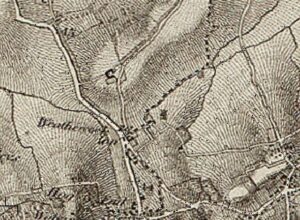
A Jury List for Bedfordshire in 1830 (published in BHRS vol. IV), gives John Lane as the miller of Aspley Mills, but by 1832, another Bedfordshire Poll Book gives Henry Durrant of Aspley Mills, eligible as a voter by virtue of his Mill and Land occupied as tenant at a yearly rent of £50. Henry Durrant was to see out the end of the working life of Aspley Mill.
Durrant had come from Friston in Suffolk, a small village near Aldeburgh. On 27th January 1831, he had married Elizabeth Ward of Wavendon at Aspley Guise. He and two of his employees are mentioned in a report in the Bucks Gazette on 23rd March 1839 on the Bedfordshire Lent Assizes:
“William Rooker, 27, Aspley, committed the 12th of January, by the Rev. James Reed, charged on oath with having feloniously stolen 2½ bushels of wheat flour, of the value of 25 shillings, the property of Henry Durrant. James Goodwin, nephew of the prosecutor, who keeps a mill at Aspley Guise – On the 14th January I missed a sack of flour from the mill; one of the shutters had been taken down, and there was some flour on the outside of the mill; in consequence of some suspicion I went with the constable to the prisoner’s house, and found about 132lbs. of flour, of the same kind as that which we lost; his wife was making dough of it.
Henry Sharp – l work at the mill; the Friday I saw the sack of flour there; and then fastened the window, locked the door, and took the key into master’s house.
Prisoner – l am innocent of the crime as lays before me, as innocent as a new born babe.
The Jury returned a verdict Guilty, when the gaoler produced a certificate of the previous conviction of the prisoner of felony. Sentence, to be imprisoned in the house of correction and kept to hard labour for one year.”
The Huntingdon, Bedford & Peterborough Gazette of 30th March 1839 added that when Rooker’s house was searched, “…about 132lbs. of flour was found under the stair hole”. When he reached the Bedford New House of Correction, his details were logged, thus we know he was 5 feet 10 inches tall, with brown hair, grey eyes and a fair complexion. He could read and write imperfectly and was born in Wendon, Essex. His previous charge had been for stealing hay two years before, for which he had received one week’s hard labour.
Just over a year later, Durrant suffered another theft, which was reported by the Bedfordshire Mercury on 11th April 1840:
“Beds Easter Quarter Sessions Trials of Prisoners Wednesday April 8th.
James Chambers was indicted for stealing a quantity of flour, the properly of Henry Durrant, of Aspley Guise. Henry Durrant stated that on the 21st of Feb. last, he lost 7½ bushels of flour from his water mill; he got a search-warrant to search Chambers’s house, and found there about half a bushel of flour in a pan under the bed; it was like what he had lost; he could swear it was the same; witness then went to the Heath to look for the prisoner, but he was gone and had left his tools behind him. Cross-examined by Mr. Byles. There was very small quantity of flour spilt on the floor of the mill, which he swept and compared with what he found; would swear it was the same.
James Goodden who works at Mr. Durrant’s mill, corroborated this evidence.
Henry Sharp locked the mill on the 21st of February, next morning he was first at the mill and found two of the doors open. He had boulted [sieved] the flour over night.
John Abbey, constable of Fenny Stratford, apprehended prisoner about quarter of a mile from Rumford Turnpike-gate, and found half a score skeleton keys upon him and a knife.
Mr. Byles addressed the jury for the prisoner, and they were then told to consider their verdict. After consulting some time the Foreman rose to deliver it, and upon being asked by the Clerk of the Peace whether they found the prisoner, James Chambers, guilty or not guilty, he said, “Why, we can’t make it out exactly clear again’ ’im.”
The Clerk of the Peace – Then you say, “He is not guilty.”
The Foreman – Why don’t see ’tis exactly made out as he stole the flour.
The Clerk of the Peace – Then you say “He is not guilty.” Do you say so. or do you not?
The Foreman, (after glance or two at his brother jury men) – Yes, yes sir, we do.
A verdict of not guilty was accordingly recorded.”
One can only imagine the consternation of the Court officials, faced with a broad Bedfordshire yokel’s dialect and the indecision! It would appear that Rumford is the old-fashioned name for Romford and thus Chambers had been chased down and caught in (what was then) Essex. The Quarter Session Records at Bedfordshire Archive [QSR1840/2/5/6] state that Chambers was working on the Eastern Counties Railway. He too was recorded in the Bedford Gaol Register. He was from Bow Brickhill, 5-foot 6-inches tall with a scar on the right leg and was 35 years of age.
Although he was acquitted on this theft charge, Chambers was not so lucky the next time. Along with his brother, he stole a pig from Mr. Gadsden at Heath and Reach in 1845. The Bedfordshire Mercury described him as “the notorious James Chambers, of Bowbrickhill, Bucks, who has been a terror to that neighbourhood for so long…” This time he was found guilty and transported for 10 years. His brother had already received 15 years for the same offence, but James had absconded so I’m surprised they gave him less. When eventually chased down and caught, he broke several pairs of handcuffs, finally being subdued by six men who put another four pairs on him!
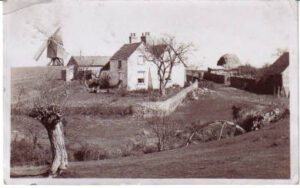
Sadly the 1841 census of Aspley Guise is too feint to clearly decipher, but it appears there was a Durrant family living in the Weathercock area. In 1846, the Bedford to Bletchley railway was opened, passing just 100m north of the mill. The juxtaposition of one of the oldest forms of industry and the newest would have made in interesting contrast. There was originally a trackway that joined the mill to Cranfield Road, but this was bisected by the line, as was Cranfield Road itself. This was rerouted from its original position of running along the back of the recreation ground, turning sharply and running alongside the railway to meet Newport Road. Thus, having to have two level-crossings near each other was avoided. Henry’s father, also Henry, had come to live with his son at Aspley Guise from Friston and passed away in 1847, aged 89.
That same year, Durrant suffered another theft. Details were recorded in the Quarter Session Records for 20th June 1847 [BARS: QSR1847/3/5/41] where Durrant is described as miller of a water mill in Aspley Guise, which does not adjoin the house. He brought a case against John Paine of Aspley Guise, pig dealer and horse dealer, of stealing two bushels of wheat. Durrant had about 4 loads of wheat in a bin in the upper part of the mill which he had bought from Mr. W. Warr. It was mixed wheat, red and white. On Tuesday evening he missed 2 bushels or more. On that day he had seen a little back window was unfastened. He examined the sleeve from that bin to the room underneath and saw it was left in a way he never does. From information received, he went the next morning to the house of John Paine, a few hundred yards from the mill. He asked to see the wheat Paine had in his house. Paine at first said he might, then hesitated and said his wheat came from below Elstow. He went in and saw a sack standing in a back room. He took some wheat out and it corresponded exactly with his. Paine said he did not know who he bought the wheat from, that he had it in a swap at Elstow Fair. He said it was stolen wheat. He took another sample out of the sack (produced in Court). He is sure that at that time there were no split peas among the wheat. The sample corresponded with the sample of his own wheat in every way, with little chaff, some broken corns and a very little mice dung. He saw the sample in the blue bag taken out of the sack in the prisoner’s house last night. There were split peas in it. Paine could have done what he pleased with the sack since he was at Paine’s house yesterday morning. A man might have got in by the window which he found unfastened.
Elizabeth Durrant, wife of Henry Durrant – on Tuesday evening she went to Paine’s house. She went into the back room and saw a sack standing there covered with a sheet. She put her hand on it and felt it was small corn in it. She did not say anything to Paine about it.
Samuel Barratt of Aspley Guise, labourer – he knows Paine. On Monday morning he was coming from Durrant’s mill towards Woburn Sands at a few minutes after 3am. He was on his way to watch game for Mr. Hoare’s keeper. As he was getting over the gate from Durrant’s premises into the road near Paine’s house he saw Paine and a young man about 20 yards away. The young man said it was a fine morning – it was then raining hard. Paine turned his back on him and walked towards his own house. Paine had an empty sack on his arm. About 3.45am that morning he was in the high road near the Sands. Paine passed him on the road towards Woburn with an empty sack on his arm and said good morning. The young man had a brown smock on and went towards the Weathercock. He does not know Clem Emerton but has heard of him. He cannot say whether the young man was Clem Emmerton or not.
John Paine – he was going to Aylesbury Fair on Monday morning and had a sack to put over his shoulders because it rained. About 5 or 6 weeks ago he was at Elstow Fair and had exchanged a horse for 8 bushels of wheat. The man he exchanged with brought the wheat to his house and then had the horse. They did not know each other. The man brought the wheat in a sort of dealer’s cart. The man did not tell him his name and said he came from beyond Elstow. He thinks this was in May. The split peas were in the wheat when he bought it. They disputed about it.
The Bedfordshire Mercury briefly mentioned the case. Paine, 41, was found guilty and sentenced to six months in the House of Correction.
In the book “The Story of Aspley Guise”, (WSDS, 1980) it states that “miller Durrant and timber merchant Whitlock” carted all the materials for the building of the Primitive Methodists’ chapel on Aspley Hill, which opened in 1849. It appears the Durrant’s had converted since their marriage in 1831 in the Church of England, as their sons John and George were baptised in the Congregationalists chapel at Woburn in 1836. In 1850 he was in Court again, but this time he had been called as a juryman for the Quarter Sessions of the Peace.
We find his family on the 1851 census listed under “Aspley Mills” in Aspley Guise, when he and his wife had been together for 20 years and had been milling here for at least 19:
- Henry Durrant, Head, 53, Miller, born Suffolk
- Elizabeth Durrant, wife, 48, Wavendon
- George Durrant, son, 16, Aspley
- John Durrant, son, 14, scholar, Aspley
- Jane Durrant, daughter, 13, scholar, Aspley
- William Durrant, son, 10, scholar, Aspley
- Frederick Durrant, son, 8, scholar, Aspley
- Ann Ward, wife’s sister, Unmarried, 46, Cook, Wavendon
- Ann Eaton, servant, unmarried, 17, General Servant, Simpson
The Durrant’s had also had a daughter, Sarah, in 1833, but she had only survived for two weeks. The 1861 census entry for “Aspley Mill”, in Aspley Guise has substantially less occupants:
- Henry Durrant, Head, 63, Miller & farmer of 26 acres employing 1 man & 2 boys, born Friston, Suffolk
- Elizabeth Durrant, Wife, 58, Wavendon
- Benjamin Dolton, Servant, 14, Servant, Wavendon
His farm land was likely to be the fields around the mill alongside the railway line. If business was booming, I would have expected at least one of his sons to be working with him but they had all left home. George was married and living not far away in Wolverton, working as a miller, with his sister Jane living with them too; John had moved to St. Mildred’s Court in the City of London where he was a Banker’s Clerk although he married a Wavendon-born lady, Jemima Tite, in 1862. William was living in the household of his uncle Joseph Hexby in Woburn, where he was a carpenter. Frederick is now listed under the Woburn Workhouse in George Street with an occupation of “Porter”, I presume working there, as ten years on he was married and a Heraldic stationer in Belsize Road, London.
Durrant’s name, along with his employee George Rich, crop up in another theft, this time of barley and peas in a Bedfordshire Mercury of 21st March 1863:
“BEDFORDSHIRE LENT ASSIZES – CROWN COURT – SECOND DAY. WOBURN. STEALING CORN.
James Clare, 34, labourer, was charged with stealing 3 half-pecks of beans, and 2 bushels of barley and peas mixed, value 8s. 6d., the property of George Kemp, Woburn, on the 23rd of January, 1862. Mr. Bullock prosecuted. Dr. Abdy defended.
George Kemp: I keep the Sun Inn at Woburn; the prisoner was in my employ on 23rd of January; I came home on that evening about six o’clock; I went for a sack in the place which I left in the same place as the beans; I could not find the sack and I missed the beans; I asked the prisoner where the sack was; he said he did not know where the sack was; the beans were sprinkled about the place as though they fell through a hole in the sack; by the scattered beans I traced the sack to Mr. Hawkins’ hedge with 3 half-pecks of beans in it; I watched it for an hour and a half and then I sent for the prisoner; when he came in I told him if he did not fetch the sack and what was in it I would have him locked up; he said he did not know what I meant; I said it is no use you saying you don’t know what I mean; he said ”If you will not have me locked up I will go and fetch them,” he went straight to the hedge and I followed him; when he got to the hedge he said, “Here they are;” I said “Then bring them with you;” he laid them across his shoulders and brought them into the house; I did not tell him I had found the sack in the hedge. About eleven o’clock the same day I had measured out eight bushels of barley and peas and told the prisoner to take them to Mr. Durrants mill, at Woburn Sands to be ground; I measured them in his presence and he held the sack; on the following Saturday the miller’s man brough back the barley-meal. The value of two bushels was about 7s.
By the Judge: I did not measure the meal when it came back, but have had meal from the mill in the same sacks and I believe there were two bushels missing.
George Rich: I work for Mr. Durrant, miller, of Woburn Sands; in the forenoon of the 23rd of January the prisoner brought 6 bushels of peas and barley with cart and two sacks; it was in two bags and one contained barley, and the other barley and peas. We went to the cart, and he again said there was 6 bushels; we took the bags to the mill; we did not measure it at the mill; I am in the habit of handling quantities of corn, and, by handling, formed the opinion that there were six bushels; when we went to grind the next day, the sacks appeared to be in the same state, and I put in the hopper about three bushels out of each sack; the meal was put into the sack – still the same quantity and took it to the prosecutor’s.
Cross-examined: We ground no more meal that day. Police-constable Alfred Ing: I took the prisoner into custody, and told him he was charged with stealing 3 half-pecks of beans and 2 bushels of barley and peas. He said Kemp know all about it.
Cross-examined: I did not search the prisoner’s house; I did not look over the road which the cart passed over, to see if there were any peas or barley on the road. Dr. Abdy, in making his defence for the prisoner, said the fact of the beans being found by the prisoner in the hedge ought not to be taken as evidence of guilt; the prosecutor in looking for the beans had found the beans in the hedge, and the prisoner, as the servant to the prosecutor, being imperatively told to find out the beans, endeavours to find them; naturally enough, found the same trace as his master and led his master to the place. It certainly was not the conduct of a guilty man. Others might have taken the beaus and placed them where they were found. Of the second charge of stealing the barley and peas the learned counsel pointed out the improbability of the prisoner disposing of the meal on the way to the mill; it was in the middle of the day, when there was no opportunity of stealing the barley and peas, and the miller’s man did not measure the quantity; he had stated his opinion but the jury ought to have something more to depend upon than mere opinion.
William Ralph Young: I am superintendent of the police at Woburn; I have known the prisoner 18 years and I have never known anything bad against him.
Police-constable Alfred: I have known the prisoner seven years and he has borne a good character for honesty. His Lordship then summed up, and the jury found the prisoner –
Guilty of stealing the beans, and recommended him to mercy on the grounds of his previous good character. His Lordship regretted to say that this was one of those cases in which a good character was not of weight; if a man plundered his master, it was a serious offence, although the amount might not be large. Sentence: Four months’ imprisonment with hard labour.”
Clare was 34. After getting out of prison in July, he was back in prison before a year had passed for stealing four brass nuts, two bolts and a piece of lead, the property of John Green of Woburn, who had employed him out of charity in wheeling dung in his garden in exchange for some bread. At this trial he was described as deaf. He said he had found the items on the dung-heap and fully intended to hand them to the owner. This was not believed. Having a prior conviction, this time he got 12 months.
The 1871 census shows the elderly Durrant’s were now the only occupants of Aspley Mill:
- Henry Durrant, Head, 73, miller & farmer 27 acres employing 2 man & 1 boy, born Preston [sic] Suffolk
- Elizabeth Durrant, wife, 68, Miller’s wife, Wavendon
It would appear that the mill closed when Henry Durrant left to retire, sometime between 1871 and 1876, as there is no miller listed in the 1876 Harrods Directory of Aspley Guise or Woburn Sands, although if trade had dwindled to such a low level, it may not have been worth listing.
By the time of the 1881 census, the Durrant’s had moved to Mount Pleasant, about five households further up the road than where the Wheatsheaf inn stood:
- Henry Durrant, Head, 83, Retired miller, born Friston, Suffolk
- Elizabeth Durrant, wife, 78, Wavendon
Meanwhile, back at Aspley Mill, there were new occupants in a new trade:
- Andrew Dolton, Head, 36, Coal heaver, born Aspley Guise
- Elizabeth Dolton, wife, 33, Hat sewer straw, Aspley Guise
- Jethro B. Dolton, son, 11, scholar, Aspley Guise
- Annie M. Dolton, daughter, 10, scholar, Aspley Guise
- Sophia Dolton, daughter, 6, scholar, Aspley Guise
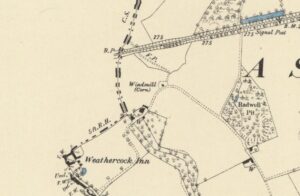
Henry Durrant’s death was reported in the Leighton Buzzard Observer & Linslade Gazette of 21st December 1886: “Durrant. – On the 12th inst, at Woburn Sands, Henry Durrant, 45 years at the Mills, Aspley Guise, aged 89 years.” – quite an age to reach after so long a life of physical labour. His widow Elizabeth survived another five years. From the same paper, 24th March 1891, after discussing the death of another aged widow: “Mrs. Durrant, widow of the late Mr. Henry Durrant, for nearly half a century occupier of the Aspley Mill died also on the same day, at the age of eighty-seven.”
The large Dolton family were still there at the time of the 1891 census of “Windmill Cottage, Aspley Guise”. (A Dolton had been the Durrant’s servant in the 1861 census, but I haven’t established if he was connected to these Dolton’s):
- Andrew Dolton, Head, 44, Brickmaker, born Aspley Guise
- Elizabeth Dolton, wife, 43, Aspley Guise
- Benjamin Dolton, son, single, 21, Engine cleaner LNWR, Aspley Guise
- Wilfred Dolton, son, 13, Grocer’s errand boy, Aspley Guise
- Fanny Dolton, daughter, 10, scholar, Aspley Guise
- Emily Dolton, daughter, 6, scholar, Aspley Guise
- Denis Dolton, son, 4, scholar, Aspley Guise
- Mabel C. Dolton, daughter, 1, Aspley Guise
The windmill itself survived another nine years, just into the 20th century, until a great storm finally destroyed it. From the Leighton Buzzard Observer & Linslade Gazette of 11th December 1900:
“The storm which raged in this neighbourhood on Wednesday night last was responsible for what, amongst lovers of things ancient, will be looked upon as little short of a catastrophe. When the news became known that the old windmill at Woburn Sands, which has served as a landmark of the neighbourhood from time immemorial, had been blown down, many felt that they had lost an old friend, which they had learned to love, by reason of its great age and former usefulness. It is nearly forty years since the building was last used for the purpose of grinding corn, so that only those of middle age can remember it in its palmiest days. The old mill has weathered many severe storms, but its inevitable collapse was brought about by what was perhaps the strongest gale that has blown in this neighbourhood tor many years. The wreckage has been visited number of sightseers.”
…and from the Ampthill & District News, 15th December:
“The old windmill, which has for a great number of years stood erect on the estate of Sir Henry Hoare, near the railway, was blown down during the heavy wind on Wednesday week. This old relic has been admired and painted by numerous artists who have visited Woburn Sands.”
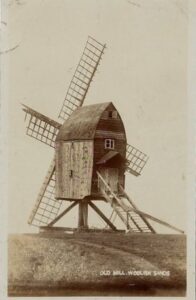
Out-of-use for 40 years, there would have been few who could remember it working at the time of its demise. Apart from Woburn’s ‘K’ company of the Territorials using the area for a simulated attack practice in February 1902, it seems the windmill was quickly forgotten.
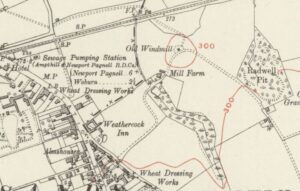
A “Mill Farm” building is still in existence near the site but I don’t think much of it is original now. All trace of the mills themselves have now long gone. The site of the windmill is beneath the 12th green of the Aspley Guise & Woburn Sands golf course, which was originally laid out as nine holes in 1914. The course was later extended and now straddles Mill Way and Mill Lane. I have been told by previous greenkeeping staff that some timber remains were dug up in the area during renovation work to that green. The watermills are beneath Burrows Close.
Millers Dates refer to years known that tenant was there and are not necessarily their whole tenure
1086 In operation
1670 Charles Fenn
1758 John Wilbee
1783 John Cox
????-1794 Thomas Clayton
1794-1797 J. Clayton
1800-1803 William Hart
1805 William Coleman
1807 John Clayton
1807-1816 William Coleman
1816- G. Hall
1830 John Lane
1832->1871 Henry Durrant
1900 Destroyed
This research comes from:
The Bedfordshire Archives catalogue entries and Community History webpage for Aspley Guise:
https://bedsarchives.bedford.gov.uk/CommunityHistories/AspleyGuise/AspleyMills.aspx
Bedfordshire Historical Record Society annual publication Vol. XIV 1931 (article by J. Steele Elliott)
Newspaper reports available on British Newspaper Archives:
www.britishnewspaperarchive.co.uk
The Historic Environment Record for Bedfordshire:
https://www.heritagegateway.org.uk/Gateway/Results_Single.aspx?uid=MBD2487&resourceID=1014
Page last updated Oct. 2021.
